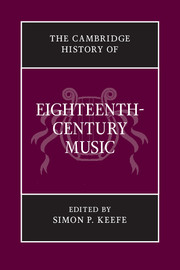Book contents
- Frontmatter
- PRELUDE
- PART I MUSIC FOR THE CHURCH
- INTERLUDE
- PART II MUSIC FOR THE THEATRE
- INTERLUDE
- PART III MUSIC FOR THE SALON AND CONCERT ROOM
- 16 Keyboard music from Couperin to early Beethoven
- 17 The serenata in the eighteenth century
- 18 Private music in public spheres: chamber cantata and song
- 19 Handel and English oratorio
- 20 The overture-suite, concerto grosso, ripieno concerto and Harmoniemusik in the eighteenth century
- 21 Concerto of the individual
- 22 Eighteenth-century symphonies: an unfinished dialogue
- 23 The string quartet
- POSTLUDE
- Appendix I Chronology
- Appendix II Institutions in major European cities
- Appendix III Personalia
- Index
- References
22 - Eighteenth-century symphonies: an unfinished dialogue
from PART III - MUSIC FOR THE SALON AND CONCERT ROOM
Published online by Cambridge University Press: 28 March 2011
- Frontmatter
- PRELUDE
- PART I MUSIC FOR THE CHURCH
- INTERLUDE
- PART II MUSIC FOR THE THEATRE
- INTERLUDE
- PART III MUSIC FOR THE SALON AND CONCERT ROOM
- 16 Keyboard music from Couperin to early Beethoven
- 17 The serenata in the eighteenth century
- 18 Private music in public spheres: chamber cantata and song
- 19 Handel and English oratorio
- 20 The overture-suite, concerto grosso, ripieno concerto and Harmoniemusik in the eighteenth century
- 21 Concerto of the individual
- 22 Eighteenth-century symphonies: an unfinished dialogue
- 23 The string quartet
- POSTLUDE
- Appendix I Chronology
- Appendix II Institutions in major European cities
- Appendix III Personalia
- Index
- References
Summary
No genre worked harder in the eighteenth century than the symphony, which opened and closed concerts, punctuated the Catholic mass and introduced plays, operas and oratorios, whose overtures were classified by contemporary writers as ‘theatre symphonies’ and ‘church symphonies’. Meeting all these needs resulted in a vast and varied repertory. ‘Chamber symphonies’ alone, the focus of this chapter, number several thousand and, as anyone familiar with Haydn’s or Mozart’s symphonies knows, they draw on every conceivable resource of form, style and mood.
Studies of eighteenth-century symphonies are equally diverse and, after two centuries, almost as numerous as the works themselves. Pedagogues of the time dissected examples by Haydn and others for the benefit of would-be imitators. Critics sought to capture expressive implications by drawing comparisons to odes, choruses, character representations, dialogues and comedies. Some nineteenth- and early-twentieth-century scholars, reflecting the nationalist preoccupations of their age, argued whether the most important predecessors of Haydn came from Italy, Austria, or Germany, while others analysed form, phrasing, harmony and thematic development in an investigation that continues today. Still others have examined how descriptive annotations, conditions of performance, or evocative melodies and rhythms influenced the meanings that symphonies communicated to listeners.
- Type
- Chapter
- Information
- The Cambridge History of Eighteenth-Century Music , pp. 613 - 647Publisher: Cambridge University PressPrint publication year: 2009
References
- 3
- Cited by

